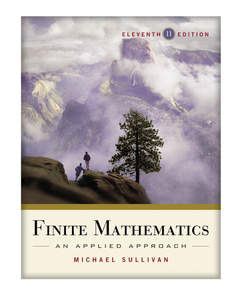Finite Mathematics (11th Ed.) An Applied Approach
Auteur : Sullivan Michael

Finite Mathematics: An Applied Approach, 11th Edition once again lives up to its reputation as a clearly written, comprehensive finite mathematics book. This Edition builds upon a solid foundation by integrating new features and techniques that further enhance student interest and involvement. All existing problems have been updated to provide relevance and timeliness. Finite Mathematics contains the same elements such as Step-by-Step Examples, Exercise Sets, and Learning Objectives in every chapter. In an engaging and accessible style, this text demonstrates how mathematics applies to various fields of study. The text is packed with real data and real-life applications to business, economics, social and life sciences.
1.1. Lines.
1.2. Pairs of Lines.
1.3. Applications to Business and Economics.
1.4. Scatter Diagrams; Linear Curve Fitting.
Chapter Review.
Chapter Project.
Chapter 2: Systems of Linear Equations.
2.1 Systems of Linear Equations: Substitution; Elimination.
2.2 Systems of Linear Equations: Gauss-Jordan Method.
2.3 Systems of m Linear Equations Containing n Variables.
Chapter Review.
Chapter Project.
Chapter 3: Matrices.
3.1 Matrix Algebra.
3.2 Multiplication of Matrices.
3.3 The Inverse of a Matrix.
3.4 Applications in Economics (the Leontief Model), Accounting, and Statistics (the Method of Least Squares).
Chapter Review.
Chapter Project.
Chapter 4: Linear Programming with Two Variables.
4.1 Systems of Linear Inequalities.
4.2 A Geometric Approach to Linear Programming Problems.
Chapter Review.
Chapter Project.
Chapter 5: Linear Programming: Simplex Method.
5.1 The Simplex Tableau; Pivoting.
5.2 The Simplex Method; Solving Maximum Problems in Standard Form.
5.3 Solving Minimum Problems Using the Daily Principle.
5.4 The Simplex Method for Problems Not in Standard Form.
Chapter Review.
Chapter Project.
Chapter 6: Finance.
6.1 Interest.
6.2 Compound Interest.
6.3 Annuities; Sinking Funds.
6.4 Present Value of an Annuity; Amortization.
6.5 Annuities and Amortization Using Recursive Sequences.
Chapter Review.
Chapter Project.
Chapter 7: Probability.
7.1 Sets.
7.2 The Number of Elements in a Set.
7.3 The Multiplication Principle.
7.4 Sample Spaces and the Assignment of Probabilities.
7.5 Properties of the Probability of an Event.
7.6 Expected Value.
Chapter Review.
Chapter Project.
Chapter 8: Bayes' Theorem; The Binomial Probability Model.
8.1 Conditional Probability.
8.2 Independent Events.
8.3 Bayes' Theorem.
8.4 Permutations.
8.5 Combinations.
8.6 The Binomial Probability Model.
Chapter Review.
Chapter Project.
Chapter 9: Statistics.
9.1 Introduction to Statistics: Data and Sampling.
9.2 Representing Qualitative Data Graphically: Bar Graphs; Pie Charts.
9.3 Organizing and Displaying Quantitative Data.
9.4 Measures of Central Tendency.
9.5 Measures of Dispersion.
9.6 The Normal Distribution.
Chapter Review.
Chapter Project.
Chapter 10: Markov Chains; Games.
10.1 Markov Chains and Transition Matrices.
10.2 Regular Markov Chains.
10.3 Absorbing Markov Chains.
10.4 Two-Person Games.
10.5 Mixed Strategies.
10.6 Optimal Strategy in Two-Person Zero-Sum Games with 2 X 2 Matrices.
Chapter Review.
Chapter Project.
Chapter 11: Logic.
11.1 Propositions.
11.2 Truth Tables.
11.3 Implications; The Biconditional Connective; Tautologies.
11.4 Arguments.
11.5 Logic Circuits.
Chapter Review.
Chapter Project.
Appendix A: Review.
A.1 Real Numbers.
A.2 Algebra Essentials.
A.3 Exponents and Logarithms.
A.4 Recursive Defined Sequences: Geometric Sequences.
Appendix B: Using LINDO to Solve Linear Programming Problems.
Appendix C: Graphing Utilities.
C.1 The Viewing Rectangle.
C.2 Using a Graphing Utility to Graph Equations.
C.3 Square Screens.
C.4 Using a Graphing Utility to Graph Inequalities.
Answers to Odd-Numbered Problems.
Photo Credits.
Index.
Date de parution : 09-2011
Ouvrage de 864 p.
21.1x25.7 cm
Thème de Finite Mathematics :
Mots-clés :
linear; lines; applications; linear equations; systems; substitution; equations; gaussjordan; matrices; multiplication; matrix; inverse; model; economics; leontief



